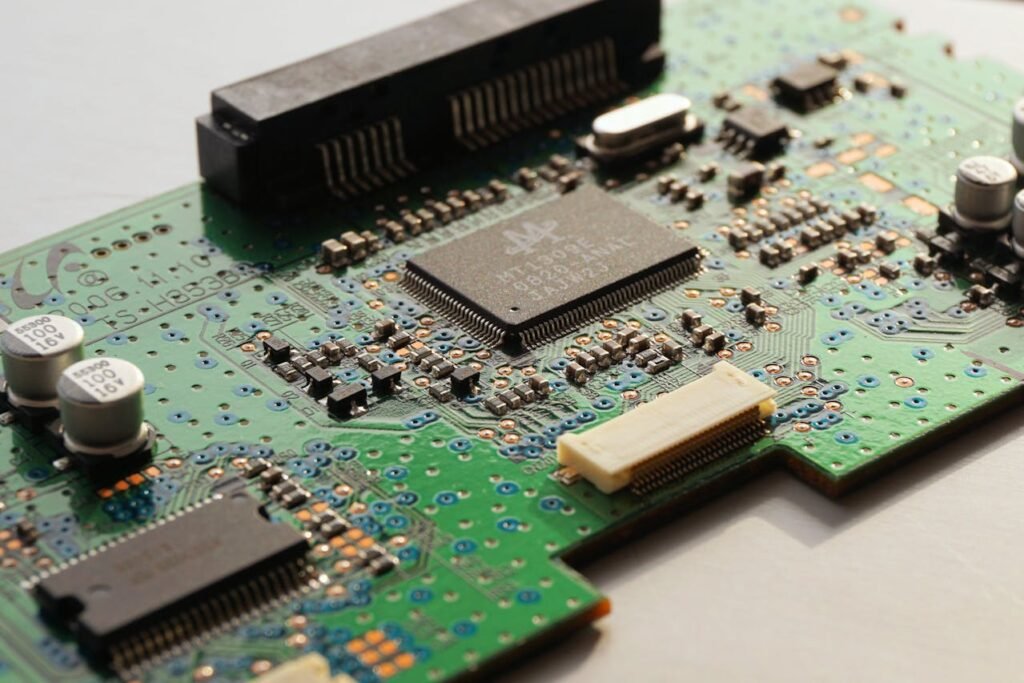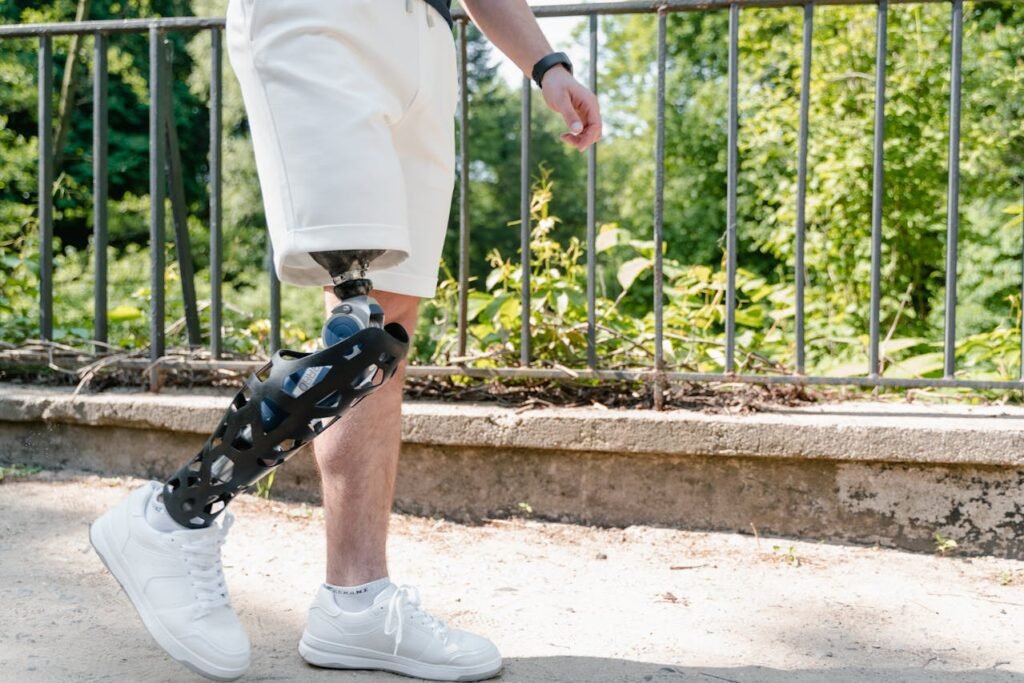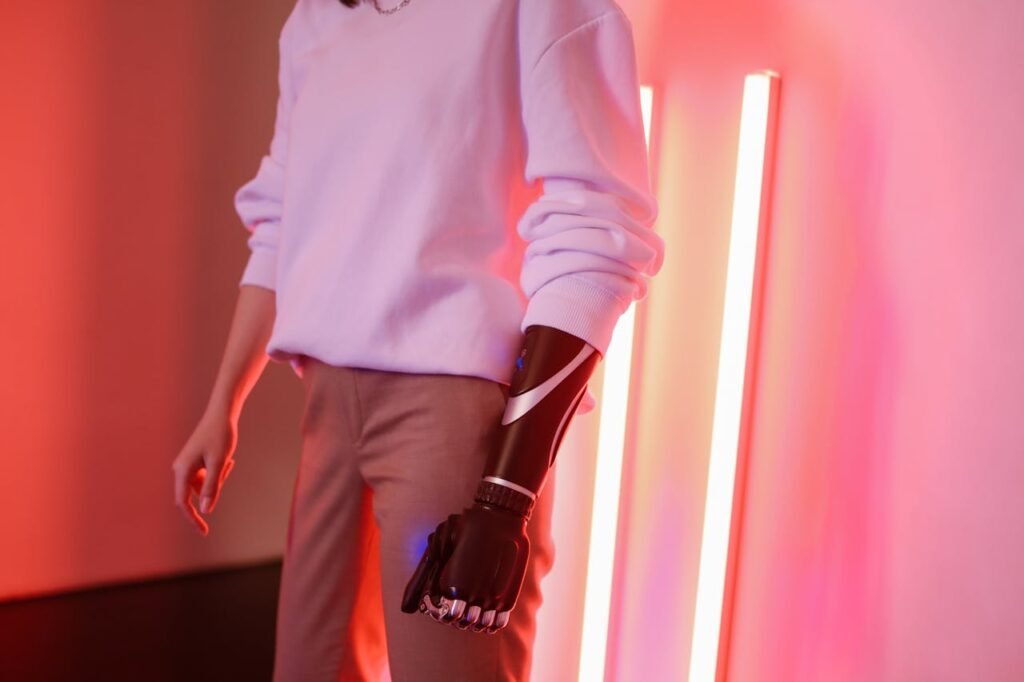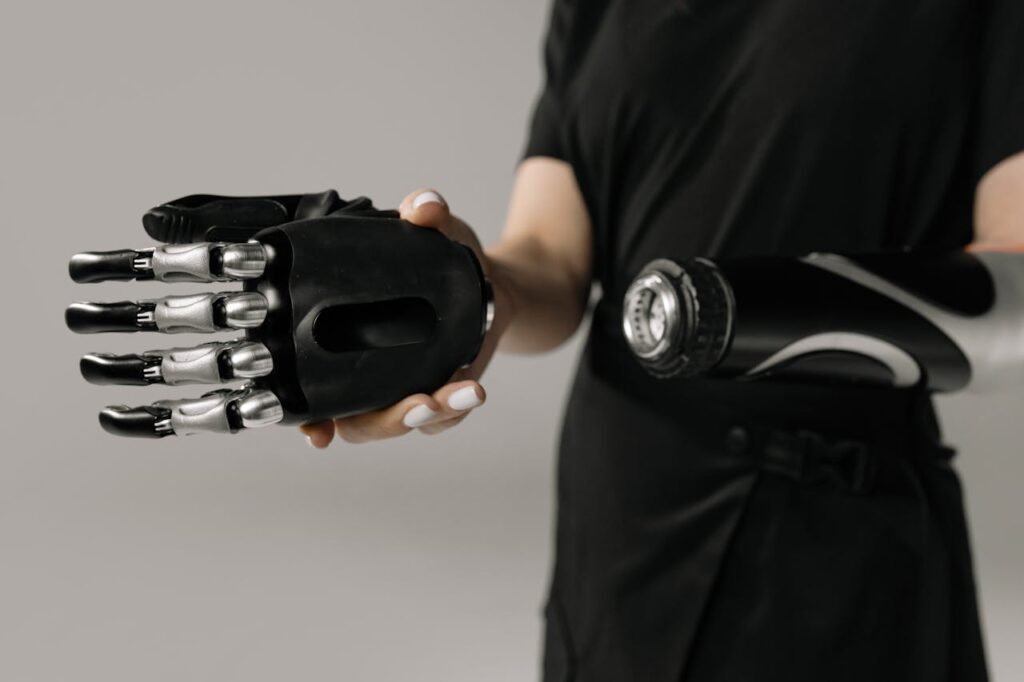The loss of an arm can feel like losing a part of your identity. Everyday tasks, once effortless, become challenges. But thanks to advances in myoelectric prosthetics, arm amputees now have tools that not only restore functionality but also rebuild confidence and independence. These cutting-edge devices respond to muscle signals, enabling precise and natural movements that make life more manageable and fulfilling.
This article dives deep into how myoelectric prosthetics are transforming lives, the technology behind them, and why they represent a breakthrough for users and the industry. Whether you’re an amputee considering options, a caregiver, or simply curious about the innovation, this guide will walk you through everything you need to know.
Understanding Myoelectric Prosthetics
Myoelectric prosthetics are redefining the world of arm prosthetics by integrating muscle activity with advanced technology. Unlike traditional mechanical prosthetics that rely on body movements or harnesses for control, myoelectric devices use electrical signals generated by the user’s muscles to perform precise movements.
How Do Myoelectric Prosthetics Work?
At the core of a myoelectric prosthetic is the ability to read and interpret muscle signals. Sensors placed on the skin of the residual limb detect electrical signals produced when the user contracts specific muscles.
These signals are then transmitted to a microprocessor within the prosthetic, which translates them into movements such as opening or closing a hand, rotating a wrist, or bending an elbow.
For instance, if a user flexes the muscles that once controlled their hand, the prosthetic’s sensors pick up the signal and mimic the action. Over time, users can refine their control, enabling more complex tasks like gripping delicate objects or performing repetitive motions.
This seamless connection between intention and action is what sets myoelectric prosthetics apart. They allow users to regain a sense of agency and control, making them not just tools but extensions of the body.
The Science Behind Myoelectric Control
At its core, myoelectric technology harnesses the body’s natural electrical signals to drive the movement of a prosthetic limb. When a person moves their muscles, even in a residual limb, their body generates electrical impulses. These signals, though tiny, can be detected by surface electrodes placed on the skin.
Myoelectric prosthetics are designed to interpret these signals and convert them into movement. The device’s microprocessor acts as a translator, decoding the muscle signals into specific commands for the prosthetic’s motors. For example, a muscle contraction might trigger the prosthetic hand to open or close, while another might rotate the wrist.
This seamless interaction between the body and the device gives users a sense of direct control, reducing the mental effort required to operate the prosthetic. Over time, users can fine-tune their movements, making the prosthetic feel like a natural extension of their body.
The Role of Advanced Microprocessors
The microprocessor is the brain of a myoelectric prosthetic, and its sophistication determines how well the device responds to the user’s input.
Modern processors use algorithms and even artificial intelligence to learn a user’s unique muscle patterns. This personalized approach ensures that the prosthetic adapts to the user, rather than forcing the user to adapt to the device.
For businesses, investing in high-quality microprocessors is critical. The speed, accuracy, and adaptability of these systems directly impact user satisfaction.
Partnering with leading technology providers or developing proprietary algorithms can give businesses a competitive edge in delivering prosthetics that outperform expectations.

Designing for Intuitive Use
One of the challenges with advanced prosthetics is ensuring they are intuitive for users. The transition to a myoelectric device involves more than just physical adaptation; it requires mental adjustment as well. Users must learn how their muscle contractions translate into prosthetic movements, a process that can feel overwhelming at first.
Businesses can address this by designing user-friendly systems with simple, clear controls. Offering guided onboarding programs, either through in-person training or digital tools, can help users gain confidence and mastery quickly.
For example, providing interactive apps that visualize muscle signals in real time can make the learning process engaging and less intimidating.
Supporting a Wide Range of Users
Myoelectric prosthetics are not one-size-fits-all solutions. The technology must be tailored to meet the diverse needs of users, from individuals with partial hand amputations to those requiring full-arm replacements.
Each case presents unique challenges, such as the placement of sensors, the range of motion required, and the strength of the muscle signals available.
For businesses, this means offering customizable solutions that address these varying needs. Modular designs, where components like the hand, wrist, and elbow can be adjusted or replaced, provide flexibility for users as their goals and requirements change.
By emphasizing adaptability in product design, companies can cater to a broader audience and deliver a more personalized experience.
Overcoming Barriers to Adoption
While myoelectric prosthetics offer unparalleled functionality, they are also among the most advanced—and therefore complex—prosthetics on the market.
Users may initially be hesitant to adopt the technology due to concerns about cost, usability, or maintenance. Businesses can play a pivotal role in overcoming these barriers by providing clear and actionable guidance.
Educational initiatives are key. Many potential users and their caregivers may not fully understand how myoelectric prosthetics work or the benefits they offer.
Hosting workshops, creating informative videos, and developing easy-to-follow user guides can demystify the technology. By positioning themselves as educators and advocates, businesses can build trust and foster greater adoption of myoelectric devices.
The Real-Life Impact of Myoelectric Prosthetics
The true measure of any technology lies in its ability to improve lives, and myoelectric prosthetics excel in this regard. For many users, these devices are life-changing, helping them reclaim activities they thought were lost forever.
Restoring Independence
One of the most immediate benefits of myoelectric prosthetics is the ability to perform daily tasks independently. Simple activities like tying shoelaces, drinking a cup of coffee, or typing on a keyboard become possible again. For users, this newfound independence is not just practical—it’s deeply empowering.
Imagine being able to carry groceries without assistance or hug a loved one with both arms. These moments, while ordinary to many, hold profound emotional significance for arm amputees. Myoelectric prosthetics make them a reality, restoring dignity and confidence.
Enhancing Career Opportunities
Beyond personal tasks, myoelectric prosthetics are opening doors professionally. Users can take on jobs that require fine motor skills, such as office work, teaching, or even creative roles like art and design.
Advanced models with multi-articulating fingers and sensory feedback provide the precision and control needed for such tasks, enabling users to excel in their chosen fields.
At Robobionics, we’ve seen firsthand how myoelectric prosthetics empower users to return to or even advance in their careers. By bridging the gap between ability and ambition, these devices redefine what’s possible.

Enabling Athletic and Recreational Pursuits
Recreation and sports are other areas where myoelectric prosthetics shine. Whether it’s playing a musical instrument, cycling, or engaging in adaptive sports, these devices allow users to pursue passions and lead active lifestyles.
For businesses in the prosthetics field, understanding the diverse needs of users is essential. Providing specialized training and customization options tailored to specific hobbies or sports can make a significant impact on user satisfaction and success.
The Technology Behind Myoelectric Prosthetics
The success of myoelectric prosthetics lies in their sophisticated design, which combines biomechanics, electronics, and human physiology. Each component plays a vital role in delivering the seamless functionality users experience.
Advanced Sensors for Precision
Sensors are the heart of myoelectric technology. These tiny, highly sensitive devices detect electrical signals from muscles with remarkable accuracy. Modern sensors can differentiate between subtle muscle contractions, allowing users to perform intricate tasks like picking up a coin or holding a fragile object.
For businesses, investing in sensor technology that prioritizes sensitivity and reliability is key. The better the sensor, the more intuitive the prosthetic feels to the user, creating a more satisfying experience.
Microprocessors and Machine Learning
The microprocessor acts as the brain of the prosthetic, processing incoming signals and translating them into movements. Recent advancements in machine learning have taken this functionality to new heights.
Prosthetics equipped with AI can adapt to a user’s unique muscle patterns over time, improving responsiveness and reducing the learning curve.
At Robobionics, we integrate machine learning into our myoelectric designs to provide a personalized experience. By analyzing how users interact with their prosthetics, our devices continually refine their performance, ensuring they remain aligned with individual needs.
Sensory Feedback: Bridging the Gap Between Technology and Touch
One of the most groundbreaking advancements in myoelectric prosthetics is the integration of sensory feedback. For decades, prosthetics focused on movement but lacked the ability to provide tactile sensations.
This created a disconnect between users and their devices, as they had to rely solely on visual cues to perform tasks. Sensory feedback bridges this gap, enabling users to feel their environment through their prosthetic.
How Sensory Feedback Works
Sensory feedback systems use specialized sensors embedded in the prosthetic’s hand or fingers. These sensors detect variables like pressure, texture, or temperature and relay that information to the user’s residual limb. Through techniques such as vibrotactile stimulation or direct nerve interface, users experience sensations that mimic touch.
For instance, when gripping a fragile object like an egg, the prosthetic’s sensors detect the applied force and alert the user if the grip is too strong. This prevents breakage and allows for precise control.
Sensory feedback transforms the prosthetic from a mechanical tool into an interactive extension of the user’s body.

Enhancing Confidence and Precision
The addition of sensory feedback has a profound psychological impact. Users report feeling more connected to their prosthetic and experience greater confidence when performing delicate tasks. It also reduces mental fatigue, as users no longer need to constantly monitor their movements visually.
For businesses, investing in sensory technology is a strategic move. As this feature becomes more refined and accessible, it will set new benchmarks in the industry, positioning companies as leaders in user-focused innovation.
Long-Term Benefits of Myoelectric Prosthetics
While the immediate advantages of myoelectric prosthetics are clear, their long-term benefits are equally significant. These devices don’t just restore functionality—they enable users to build new skills, improve their quality of life, and embrace their full potential.
Building Muscle Memory
One of the remarkable aspects of myoelectric prosthetics is their ability to help users develop muscle memory. Over time, the brain and muscles learn to work in sync with the prosthetic, creating movements that feel natural and instinctive. This allows users to perform tasks with minimal effort, enhancing both efficiency and comfort.
For businesses, emphasizing the importance of proper training and rehabilitation is crucial. Users who receive guided support during the initial stages of adoption are more likely to achieve long-term success.
Providing access to physical therapists or gamified training programs can make this process more effective and engaging.
Reducing Physical Strain
Traditional prosthetics often require users to compensate with other parts of their body, leading to strain on the shoulders, back, or neck. Myoelectric devices, however, are designed to mimic natural movements, reducing the need for compensatory actions.
This minimizes physical fatigue and the risk of long-term complications, allowing users to stay active and pain-free.
Businesses can further enhance this benefit by focusing on ergonomics during the design phase. Lightweight materials, intuitive controls, and customizable fits all contribute to a more comfortable and user-friendly experience.

Promoting Social Integration
The psychological benefits of myoelectric prosthetics extend to social interactions. Many arm amputees feel self-conscious or hesitant to engage in public activities, but advanced prosthetics help to rebuild their confidence.
The ability to shake hands, gesture naturally, or use a prosthetic that looks lifelike can make social interactions feel less daunting and more rewarding.
For businesses, this highlights the importance of offering aesthetic customization. Options such as realistic skin tones, detailed finishes, or bold, expressive designs allow users to align their prosthetics with their personal preferences, fostering a sense of pride and ownership.
Overcoming Challenges in Adoption
Despite their transformative potential, myoelectric prosthetics face certain barriers to widespread adoption. For businesses, addressing these challenges is key to ensuring that more users can benefit from this life-changing technology.
Accessibility and Affordability
Cost remains one of the biggest hurdles for many users. Myoelectric prosthetics, particularly those with advanced features like sensory feedback or multi-articulating fingers, can be expensive.
Businesses must explore ways to make these devices more affordable, whether through innovative manufacturing techniques, partnerships with healthcare providers, or financing options.
At Robobionics, we leverage 3D printing and local production to keep costs low without compromising quality. By reducing reliance on imported components, we ensure that our prosthetics remain accessible to a broader audience.
Education and Awareness
Many potential users are unaware of the capabilities of myoelectric prosthetics or feel intimidated by the technology. Businesses can address this by providing clear, user-friendly resources that explain how these devices work and what they can achieve.
Hosting workshops, offering free trials, or creating online tutorials are effective ways to demystify the technology and empower users to make informed decisions.
At Robobionics, we prioritize education, helping users and their families understand the possibilities of myoelectric prosthetics and how they can enhance daily life.
Ensuring Long-Term Support
Adapting to a myoelectric prosthetic is a journey, not a one-time event. Users need ongoing support to address technical issues, refine their skills, and adapt to changing needs.
Businesses that provide robust aftercare services, such as regular check-ins, accessible repair centers, and customer support lines, will build stronger relationships with their users.
The Future of Myoelectric Prosthetics
The field of myoelectric prosthetics is evolving rapidly, driven by technological advancements and an ever-growing understanding of human physiology. These innovations are poised to further enhance the capabilities of myoelectric devices, making them even more intuitive, accessible, and impactful.
The Integration of Neural Interfaces
One of the most exciting developments on the horizon is the integration of neural interfaces with myoelectric prosthetics. These interfaces connect directly to the user’s nervous system, enabling more precise control by translating brain signals into prosthetic movements.
Unlike traditional myoelectric devices that rely on surface muscle signals, neural interfaces allow for finer and faster responses, giving users the ability to perform complex actions seamlessly. For example, users could control individual fingers with the same dexterity as a natural hand.
For businesses, investing in research and development in this area represents a strategic opportunity. Collaborating with research institutions or technology firms can accelerate innovation and position companies as leaders in next-generation prosthetics.
Smarter Prosthetics with AI
Artificial intelligence (AI) is set to play a transformative role in the future of myoelectric prosthetics. AI-powered devices can learn from a user’s behavior, adapting to their unique muscle patterns and improving responsiveness over time.
This self-learning capability reduces the need for extensive training, making the prosthetic more intuitive for first-time users.
Imagine a prosthetic that adjusts its grip strength automatically based on the object being held or modifies its movements to suit the user’s activity, such as typing or cooking.
These advancements will redefine usability and convenience, creating a new benchmark for user satisfaction.

Enhanced Sensory Integration
Sensory feedback is already a game-changer in myoelectric prosthetics, but future iterations aim to go even further. Researchers are exploring ways to deliver more detailed sensations, such as distinguishing between textures or detecting changes in temperature.
For businesses, offering devices with enhanced sensory capabilities not only improves functionality but also deepens the emotional connection users have with their prosthetics.
These advancements will further bridge the gap between technology and biology, making the prosthetic feel like a true part of the user’s body.
The Role of Rehabilitation in Maximizing Potential
While technology is the backbone of myoelectric prosthetics, rehabilitation is the key to unlocking their full potential. The process of adapting to these advanced devices involves physical training, psychological adjustment, and continuous learning. For businesses, offering comprehensive rehabilitation support is crucial to ensuring user success and satisfaction.
Early-Stage Training
The first step in rehabilitation is helping users understand how to control their prosthetic. This involves building muscle strength, learning which movements trigger specific actions, and gaining confidence in the device’s capabilities.
Businesses can enhance this stage by providing guided training programs, either in person or through virtual platforms. Interactive tutorials, gamified exercises, and real-time feedback can make the learning process more engaging and effective.
Continuous Skill Development
As users become more comfortable with their prosthetic, their goals and needs may evolve. Rehabilitation should be a continuous process, offering advanced training that aligns with these changing objectives.
For example, a user who initially focuses on basic tasks like holding objects might later aim to master activities such as writing, playing a musical instrument, or engaging in sports.
By partnering with physical therapists and rehabilitation experts, businesses can create a structured, long-term support system. Offering modular training programs that adapt to a user’s progress ensures that they continue to grow and thrive with their prosthetic.
Emotional and Psychological Support
Adapting to a myoelectric prosthetic is as much an emotional journey as it is a physical one. Users may face challenges like frustration during the learning phase or self-consciousness in social situations. Rehabilitation programs that address these emotional aspects are essential for building resilience and confidence.
Businesses can contribute by organizing peer support groups, where users can share experiences and offer encouragement. Additionally, collaborating with mental health professionals to provide counseling services can make a significant difference in the user’s overall well-being.
Actionable Insights for Businesses
For companies in the prosthetics industry, the rise of myoelectric technology represents both an opportunity and a challenge. Success depends on not just delivering innovative products but also creating a holistic ecosystem that supports users throughout their journey.
Emphasize Education
Many potential users are unfamiliar with the capabilities of myoelectric prosthetics. Educating them about the technology, its benefits, and the steps involved in adoption can help overcome hesitation and build trust.
Businesses should invest in clear, accessible resources such as videos, brochures, and workshops that simplify complex concepts.
Prioritize Affordability
Cost is a significant barrier for many users. To expand accessibility, businesses can explore ways to lower production costs through advanced manufacturing techniques like 3D printing.
Offering flexible financing plans or partnering with insurance providers can also make these devices more attainable.
Foster Innovation Through Collaboration
The field of prosthetics is evolving rapidly, and staying ahead requires collaboration. Businesses should consider partnerships with research institutions, universities, and technology firms to accelerate the development of cutting-edge solutions.
Such collaborations not only drive innovation but also enhance credibility and market positioning.

Build Long-Term Relationships
Delivering a prosthetic is just the beginning. Businesses must focus on building long-term relationships with their users by offering ongoing support, maintenance services, and regular updates.
Creating a feedback loop where users can share their experiences and suggestions ensures continuous improvement and user satisfaction.
Conclusion
Myoelectric prosthetics are more than just devices—they are tools of transformation. By restoring functionality, enhancing confidence, and opening doors to new opportunities, these advanced prosthetics are changing the lives of arm amputees in profound ways.
For businesses, the challenge lies in not just keeping pace with technological advancements but also creating a user-centered ecosystem that empowers individuals at every stage of their journey.
At Robobionics, we are proud to be part of this revolution, combining innovation with compassion to deliver solutions that truly make a difference.



